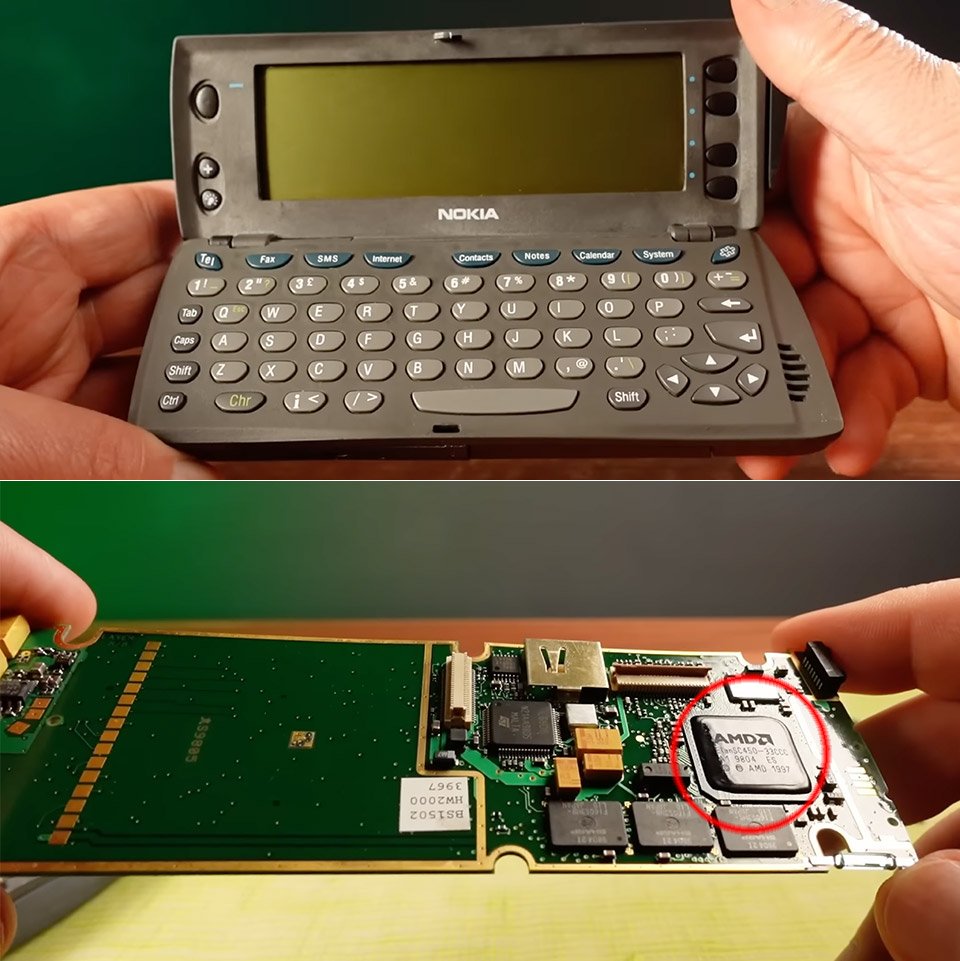Yes, the Nokia 9110 Communicator uses an AMD 486 CPU, the Elan SC450 at 33 MHz. It was a step up from the preceding Communicator’s Intel 386 and added some speed to the jobs that were important at the time.
Nokia launched the 9110 Communicator in March 1998 at CeBIT in Hannover, Germany. This was the successor to the 9000 Communicator from two years before, but with a slimmer design that didn’t feel like a brick and could be carried without a shoulder strap. When closed it was 158 mm tall, 56 mm wide and 27 mm thick, weighing 253 grams, or about half of the previous one. Flip it out from the side and the magic happens: a full QWERTY keyboard beneath a 4.5 inch monochrome LCD screen with 640×200 pixels in 16 shades of gray, with a backlight for those late night emails in a dimly lit hotel room. Nokia priced it around $1,000 in the US, which is about $2,000 today, so it was a tool for executives who needed more than just voice calls on the road.
Sale

SAMSUNG Galaxy S25 Edge Cell Phone, 256 GB AI Smartphone, Unlocked Android, Night Video, Fast Processor,…
- SUPER SLIM. SUPER LIGHT: Galaxy S25 Edge is surprisingly light and our slimmest S Series phone yet. You’ll want to show off this sleek, super-slim…
- OUR POWERFUL 200MP CAMERA ON OUR SLIMMEST S SERIES PHONE: Capture every memory in stunning clarity with our highest-resolution camera on a Galaxy…
- MORE POWER TO YOU: Reimagine what’s possible with Galaxy S25 Edge, featuring our most powerful processor yet. Effortlessly translate your calls,…
The 9110 had hardware that blurred the line between a phone and a portable computer. The AMD Elan SC450 CPU handled it all with 4 MB of RAM for programs and 4 MB of ROM for the system, plus extensible storage via MMC cards up to 4 MB at launch for documents, calendars and even simple games. The outside cover had a normal numeric keypad and a small 80×48 pixel monochrome display for quick peeks at calls or texts, powered by a replaceable 1100 mAh lithium-ion battery that could last up to 6 hours of talk time or 200 hours on standby. Connectivity was practical: a built-in GSM modem for 900 MHz networks and 9.6 kbit/s data transfer – slow by today’s standards but innovative for syncing files via cellular without a docking station. An IrDA connector for wireless transfers to printers or other devices and the whole thing ran on GEOS 3.0, a tiny operating system designed for pen input and keyboard use with a desktop-like interface that divided software into folders.
GEOS 3.0 gave the 9110 its personality and it booted up to a familiar grid of icons in 30 seconds. Email was routed through a dedicated client that retrieved messages by modem and had attachments for Word documents or simple spreadsheets. The built in web browser displayed basic HTML pages, which meant oading a news site would take minutes on the slow connection and you got formatted text as well as links you could follow with the arrow keys. Fax was a standout: type a note on the keyboard, attach a file and send it to another machine. Organizer capabilities included a calendar that synced events, a contact list with thousands of entries and a scientific calculator for quick expense calculations. You could install third party software on MMC cards, from dictionaries to travel guides, and turn the device into a personal library.
Having a 9110 was like having a lifeline for the detached traveler, because calls came in clearly on the outer earpiece, complete with vibration alerts to prevent interruptions during presentations. SMS messages appeared as brief notifications that you could archive or forward. When you went to the inner screen, it became a productivity hub. You could write a memo in the word processor, export it as a fax or send it over IrDA to a colleague’s Palm Pilot across the table. The battery lasted a full day of mixed use, but intensive data sessions would drain it quickly and you’d need to swap it with the spare Nokia included in the box. It supported up to 12 languages out of the box and was designed to MIL-STD-810 specifications.
By late 1998 the 9110 had sold 100 million units. A quiet milestone that proved it was an essential tool for professionals. An upgrade to the 9110i added WAP surfing for basic mobile web access which Club members could download from Nokia’s website so early adopters could stay current without having to replace the device entirely. Production stopped around 2000 and the 9210 and Symbian took over but the 9110’s influence can still be seen in every foldable phone that came after it.
